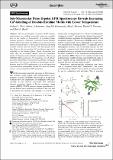Sub-micromolar pulse dipolar EPR spectroscopy reveals increasing CuII-labelling of double-histidine motifs with lower temperature
Date
19/08/2019Author
Grant ID
BB/R013780/1
099149/Z/12/Z
204821/Z/16/Z
Keywords
Metadata
Show full item recordAbstract
Electron paramagnetic resonance (EPR) distance measurements are making increasingly important contributions to the studies of biomolecules by providing highly accurate geometric constraints. Combining double‐histidine motifs with CuII spin labels can further increase the precision of distance measurements. It is also useful for proteins containing essential cysteines that can interfere with thiol‐specific labelling. However, the non‐covalent CuII coordination approach is vulnerable to low binding‐affinity. Herein, dissociation constants (KD) are investigated directly from the modulation depths of relaxation‐induced dipolar modulation enhancement (RIDME) EPR experiments. This reveals low‐ to sub‐μm CuII KDs under EPR distance measurement conditions at cryogenic temperatures. We show the feasibility of exploiting the double‐histidine motif for EPR applications even at sub‐μm protein concentrations in orthogonally labelled CuII–nitroxide systems using a commercial Q‐band EPR instrument.
Citation
Wort , J , Ackermann , K , Giannoulis , A , Stewart , A J , Norman , D & Bode , B E 2019 , ' Sub-micromolar pulse dipolar EPR spectroscopy reveals increasing Cu II -labelling of double-histidine motifs with lower temperature ' , Angewandte Chemie , vol. 131 , no. 34 , pp. 11807-11811 . https://doi.org/10.1002/ange.201904848
Publication
Angewandte Chemie
Status
Peer reviewed
ISSN
0044-8249Type
Journal article
Description
JLW is supported by the BBSRC DTP Eastbio. This work was supported by equipment funding through the Wellcome Trust (099149/Z/12/Z) and BBSRC (BB/R013780/1). We gratefully acknowledge ISSF support to the University of St Andrews from The Wellcome Trust.Collections
Items in the St Andrews Research Repository are protected by copyright, with all rights reserved, unless otherwise indicated.

